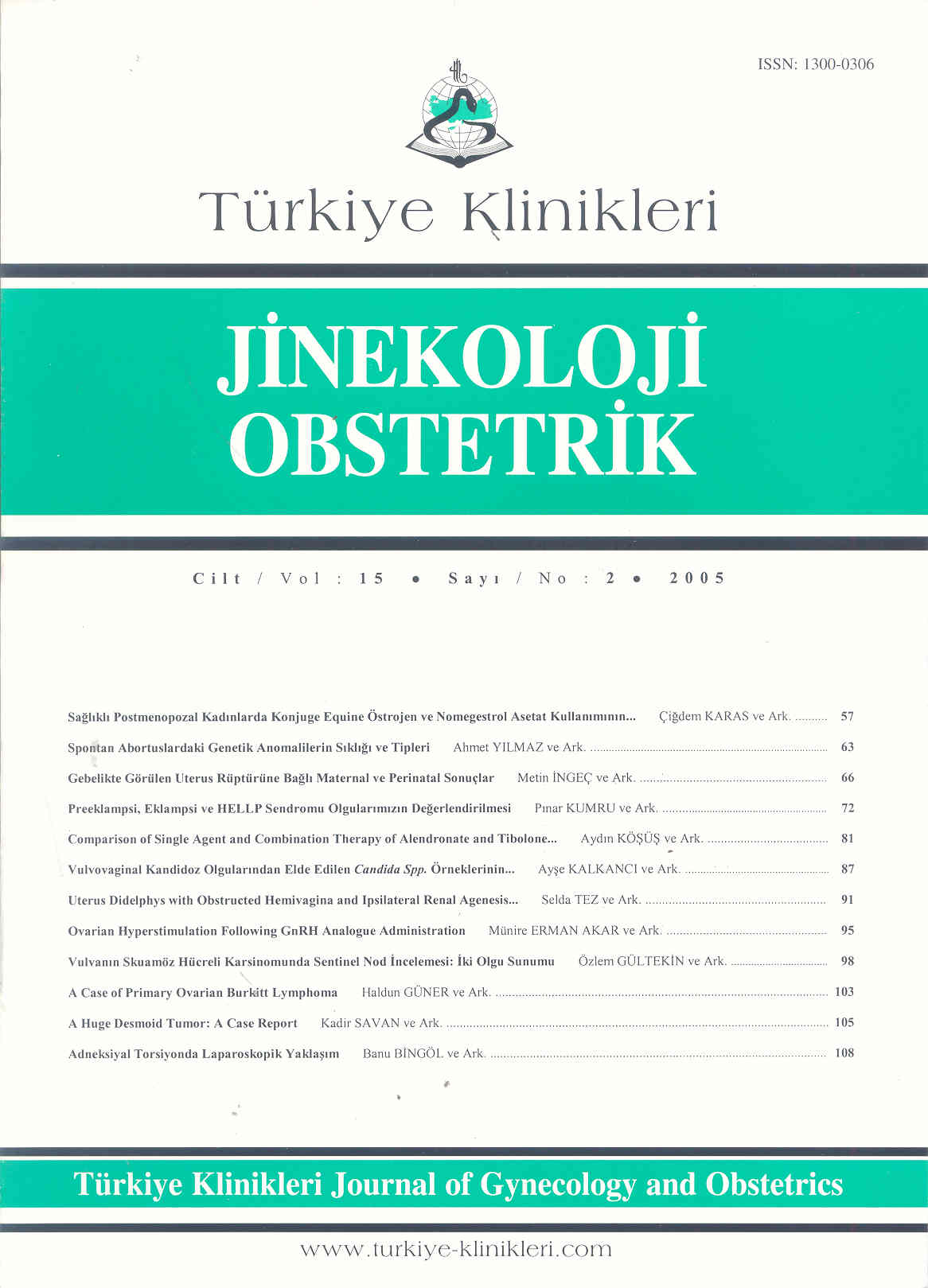Open Access
Peer Reviewed
ORIGINAL RESEARCH
2308 Viewed728 Downloaded
Comparison of Single Agent and Combination Therapy of Alendronate and Tibolone in Postmenopausal Osteoporosis
Postmenopozal Osteoporozda Alendronat Ve Tibolonun Tek Başına Ve Kombine Kullanımlarının Kıyaslanması
Turkiye Klinikleri J Gynecol Obst. 2005;15(2):81-6
Article Language: TR
Copyright Ⓒ 2020 by Türkiye Klinikleri. This is an open access article under the CC BY-NC-ND license (http://creativecommons.org/licenses/by-nc-nd/4.0/)
ÖZET
Amaç: Postmenopozal osteoporozu olan kadınlarda tek baºına tibolon (T), alendronat (A) ile T+A tedavisinin kemik mineral yoğunluğu (KMD) ve kemik turnover belirteçleri üzerindeki etkilerinin kıyaslanması. Gereç ve Yöntemler: Çalıºmaya alınan 60 osteoporozlu kadın 3 gruba ayrıldı. Bir yıl boyunca 1. gruba alendronat 10 mg/gün, 2. gruba tibolon 2.5 mg/gün (T), 3. gruba T + A verildi. Tüm gruplara 1500 mg/gün kalsiyum verildi. Tedavi öncesi ve sonrası KMD ve kemik turnover belirteçleri ölçüldü. Bulgular: KMD, T + A alan grupta diğer gruplara göre anlamlı derecede yüksekti. Tek baºına A alanlarda T alanlara göre KMDde daha fazla artıº tespit edildi. Kemik turnover belirteçleri en çok T + A grubu olmak üzere bütün gruplarda anlamlı derecede düºüº gösterdi. Sonuç: Postmenopozal osteoporozlu hastalarda T + A etkili bir tedavi rejimidir. Tek baºına A veya T ikinci seçenek olarak düºünülebilir. Kemik turnoveri yavaºlamıº ileri yaºta hastalarda, gastrointestinal hastalığı olanlarda T tek baºına verilebilir. Te-davi planlanırken hem hastanın hem ülkenin ekonomik durumu ve tedavinin etkinliği göz önünde bulundurulmalıdır.
Amaç: Postmenopozal osteoporozu olan kadınlarda tek baºına tibolon (T), alendronat (A) ile T+A tedavisinin kemik mineral yoğunluğu (KMD) ve kemik turnover belirteçleri üzerindeki etkilerinin kıyaslanması. Gereç ve Yöntemler: Çalıºmaya alınan 60 osteoporozlu kadın 3 gruba ayrıldı. Bir yıl boyunca 1. gruba alendronat 10 mg/gün, 2. gruba tibolon 2.5 mg/gün (T), 3. gruba T + A verildi. Tüm gruplara 1500 mg/gün kalsiyum verildi. Tedavi öncesi ve sonrası KMD ve kemik turnover belirteçleri ölçüldü. Bulgular: KMD, T + A alan grupta diğer gruplara göre anlamlı derecede yüksekti. Tek baºına A alanlarda T alanlara göre KMDde daha fazla artıº tespit edildi. Kemik turnover belirteçleri en çok T + A grubu olmak üzere bütün gruplarda anlamlı derecede düºüº gösterdi. Sonuç: Postmenopozal osteoporozlu hastalarda T + A etkili bir tedavi rejimidir. Tek baºına A veya T ikinci seçenek olarak düºünülebilir. Kemik turnoveri yavaºlamıº ileri yaºta hastalarda, gastrointestinal hastalığı olanlarda T tek baºına verilebilir. Te-davi planlanırken hem hastanın hem ülkenin ekonomik durumu ve tedavinin etkinliği göz önünde bulundurulmalıdır.
ANAHTAR KELİMELER: Alendronat, tibolon, kemik mineral yoğunluğu, postmenopozal osteoporoz
ABSTRACT
Objective: Aim of this study was to compare the effect of tibolone (T), alendronate (A) and T + A treatment on bone mineral density (BMD) and bone remodelling markers in postmenopausal women with osteoporosis. Material and Methods: 60 women having osteoporosis were enrolled to the study. The patients were divided into 3 groups. Alendronate 10 mg/day was given to the first, tibolone (T) 2.5 mg/day was given to the second, T + A were given to the third group for a year. 1500 mg/day calcium supplementation were given to all groups. BMD and bone remodelling markers were measured be-fore and after the treatment. Results: There was statistically significant increase in BMD in T + A group than the other two. If T and A groups compared, only A was found to be superior than T. Bone remodelling markers were found to be decreased significantly in all groups. Decrease in these markers was most significant in T + A group. Conclusion: T + A is an effective treatment regimen in patients with postmenopausal osteoporosis. Only T or only A treatment can be second choice. In older postmenopausal patients with slower bone turnover and in women with gastrointestinal disorders, only T can be ordered. The economic state of the patient and the country, the effectiveness of the treatment must be considered during planning of treatment regimen.
Objective: Aim of this study was to compare the effect of tibolone (T), alendronate (A) and T + A treatment on bone mineral density (BMD) and bone remodelling markers in postmenopausal women with osteoporosis. Material and Methods: 60 women having osteoporosis were enrolled to the study. The patients were divided into 3 groups. Alendronate 10 mg/day was given to the first, tibolone (T) 2.5 mg/day was given to the second, T + A were given to the third group for a year. 1500 mg/day calcium supplementation were given to all groups. BMD and bone remodelling markers were measured be-fore and after the treatment. Results: There was statistically significant increase in BMD in T + A group than the other two. If T and A groups compared, only A was found to be superior than T. Bone remodelling markers were found to be decreased significantly in all groups. Decrease in these markers was most significant in T + A group. Conclusion: T + A is an effective treatment regimen in patients with postmenopausal osteoporosis. Only T or only A treatment can be second choice. In older postmenopausal patients with slower bone turnover and in women with gastrointestinal disorders, only T can be ordered. The economic state of the patient and the country, the effectiveness of the treatment must be considered during planning of treatment regimen.
MENU
POPULAR ARTICLES
MOST DOWNLOADED ARTICLES





This journal is licensed under a Creative Commons Attribution-NonCommercial-NoDerivatives 4.0 International License.











